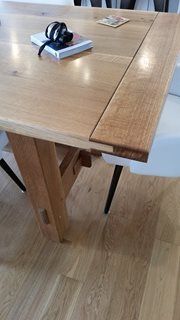I just built my first dining room table with some quarter-sawn oak, and I already have my table top glued up: 4 planks about 10" wide and two breadboards about 8" wide. The completed top is about 70" long and 40" wide and about 1-5/8" thick. After doing some research, I fear I may have been a little fast with the glue-up, and I fear I will need to chop off the breadboards and reattach them to allow for expansion. (I'm hoping I can find someone who will lend me a Domino cutter so I can use that method.)
However, I also read that quarter-sawn wood will not expand and contract nearly as much as flat-sawn, so I guess I just want to confirm with people who know more than me that I do indeed need to cut up my hard work and redo those ends. I think I know the answer, but I'd hate to do it if I don't have to.
Thanks in advance for your advice!




 Reply With Quote
Reply With Quote






